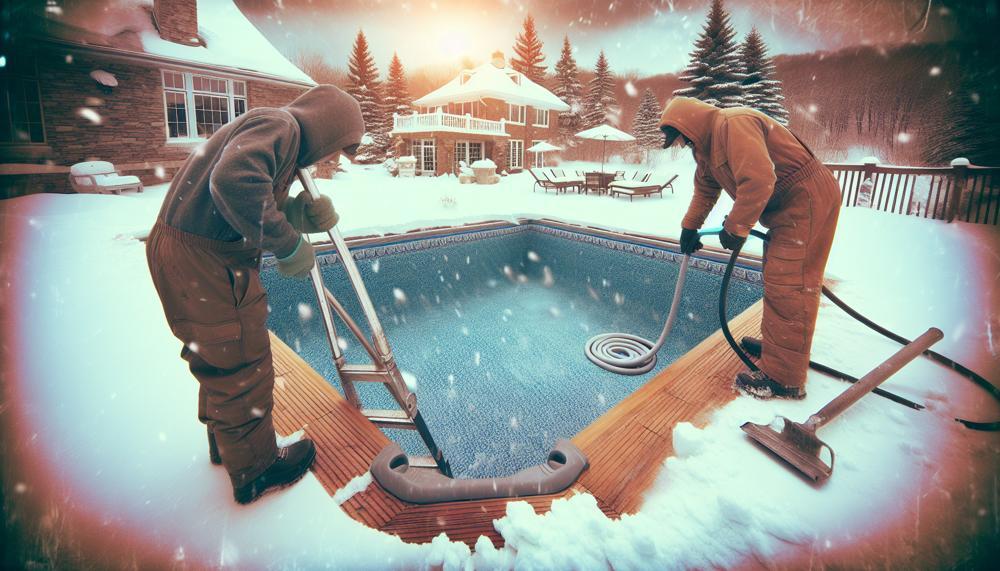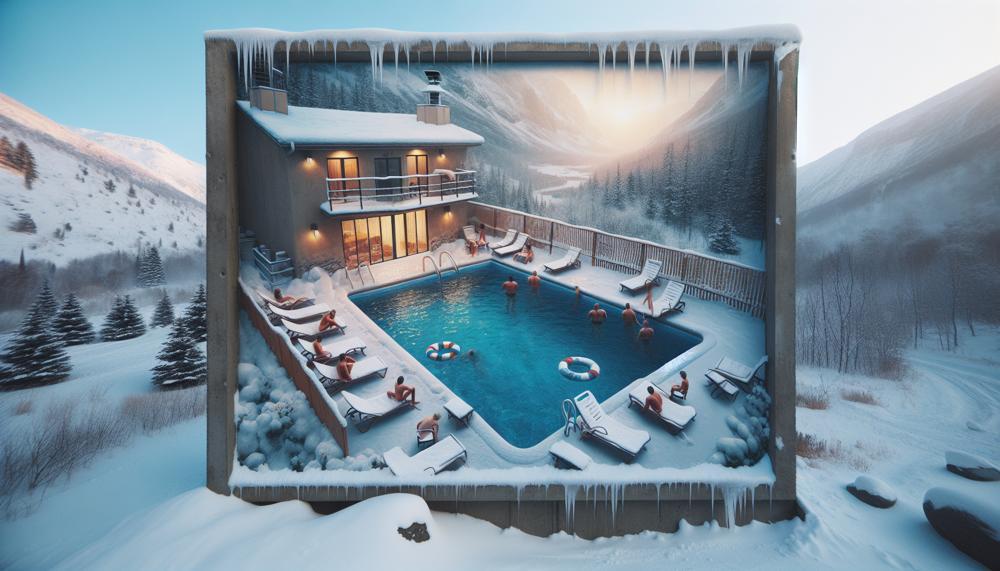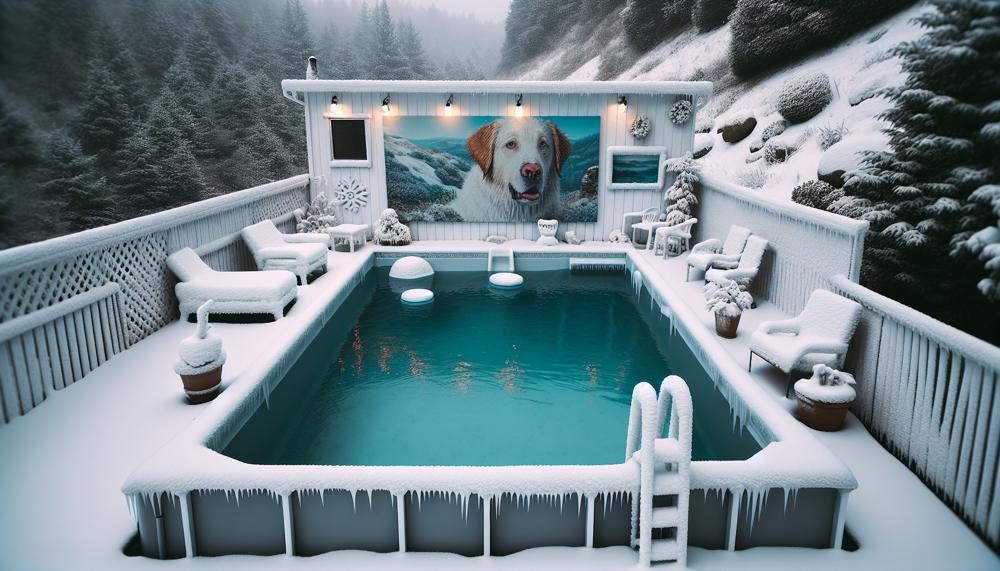As the leaves transform into vibrant hues and the crisp autumn air sets in, it’s time to turn our attention towards closing our beloved pools for the winter.
Whether you have an above ground or inground pool, properly closing it down is crucial in preserving its longevity and ensuring a hassle-free opening next season.
In this guide, we’ve got you covered with these easy-to-follow tips:
- Begin by balancing the water chemistry to prevent pesky algae growth during the off-season.
- Remove any debris from your pool, including fallen leaves, forgotten toys, and unused accessories.
- Lower the water level to below the skimmer and return lines to prevent any potential freezing damage.
- Drain all equipment, such as pumps, filters, and heaters, to avoid costly repairs come springtime.
- Safeguard your pool from harsh winter conditions with a cover specifically designed for your type of pool.
- Don’t forget about winterizing any additional features like slides or diving boards for added protection.
Closing your pool may seem like a daunting task, but by following these simple steps, you’ll ensure that your backyard oasis remains in pristine condition throughout those chilly months.
So, grab yourself a steaming cup of hot cocoa and let’s get started on closing your pool like a pro.
How To Close A Pool For Winter Above Ground And Inground?
Contents
- 1 How To Close A Pool For Winter Above Ground And Inground?
- 2 The Process of Closing an Above Ground Pool
- 2.1 Step 1: Gather Necessary Tools and Equipment
- 2.2 Step 2: Remove All Pool Accessories
- 2.3 Step 3: Test and Balance Water Chemistry
- 2.4 Step 4: Shock the Pool
- 2.5 Step 5: Add Stain-Preventer and Algaecide
- 2.6 Step 6: Seal Off Return Line
- 2.7 Step 7: Remove Pump and Filter
- 2.8 Step 8: Lower Water Level
- 2.9 Step 9: Inflate Air Pillow
- 2.10 Step 10: Install Winter Cover
- 2.11 Step 11: Regular Maintenance
- 3 The Process of Closing an Inground Pool
- 3.1 Gather Essential Tools and Equipment
- 3.2 Thoroughly Clean the Pool
- 3.3 Test and Balance Water Chemistry
- 3.4 Add Winterizing Chemicals
- 3.5 Reduce the Water Level
- 3.6 Drain Pump, Filter, Heater, and Pipes
- 3.7 Block Skimmer and Return Lines
- 3.8 Blow Out Excess Water
- 3.9 Turn Off and Clean Saltwater Generator
- 3.10 10. Remove Accessories
- 3.11 1Cover the Pool
- 4 Factors to Consider When Choosing a Closing Date
- 5 Properly Balancing and Testing Water Chemistry Before Closing
- 6 Winterizing Chemicals: What They Are and How They Help
- 7 Covering Your Pool: Types and Benefits
- 8 Conclusion
To effectively close your above ground or inground pool for the winter season, it is crucial to follow these essential steps:
Balance the water and remove accessories:
- Conduct a pH, alkalinity, and calcium hardness test on the pool water.
- Thoroughly clean and remove all pool accessories such as ladders, floaties, return fittings, solar blankets, pool alarms, pool cleaner, and diving boards.
Vacuum and add winterizing chemicals:
- Use a vacuum to remove any debris and ensure a clean pool.
- Add winterizing chemicals such as algaecide, metal sequestrant, and enzymes to prevent algae growth and maintain a clean water environment throughout the winter.
- Shock the pool and use antifreeze to prevent pipes and equipment from freezing.
Adjust the water level:
Prepare the pump and disassemble filters:
- Drain and store the pump, filter, heater, and other equipment following the manufacturer’s instructions.
- Use an air compressor to blow out all pool lines and eliminate any remaining water that could freeze and cause damage.
Cover the pool:
- Select a suitable cover (automatic, removable, solid, or mesh) to keep debris out and maintain balanced water chemistry during winter.
- Secure the cover appropriately to prevent it from blowing off in strong winds.
By following these essential steps, you can ensure proper closure of your above ground or inground pool for the winter season. Remember to regularly check on your pool throughout the off-season and make necessary adjustments to facilitate a smooth opening in spring.
The Process of Closing an Above Ground Pool
Step 1: Gather Necessary Tools and Equipment
Before embarking on the pool closing process, ensure that you have all the necessary tools and equipment. This includes a winter cover, chemical kit, air pillow, and any other accessories required for storage.
Step 2: Remove All Pool Accessories
Remove all pool accessories such as ladders, toys, and skimmer baskets from the pool. Thoroughly clean them before storing them away for the winter.
Step 3: Test and Balance Water Chemistry
It is vital to test and balance the pool’s water chemistry before closing it for the winter. This involves checking pH, alkalinity, and calcium hardness levels. Properly balanced water chemistry will prevent algae growth and safeguard the pool liner.
Step 4: Shock the Pool
After balancing the water chemistry, shock the pool with either chlorine or non-chlorine shock to eliminate any remaining bacteria or algae spores.
Step 5: Add Stain-Preventer and Algaecide
To further prevent algae growth and staining during the winter months, add a stain-preventer and algaecide following manufacturer’s instructions.
Step 6: Seal Off Return Line
To avoid ice expansion, seal off the return line with a plug. This will prevent water from entering and potentially damaging the pool.
Step 7: Remove Pump and Filter
Remove the pump and filter from the pool for storage during the winter. Ensure to properly drain and clean them before storing.
Step 8: Lower Water Level
Lowering the water level in the pool is crucial to prevent excessive expansion due to freezing temperatures. However, draining the pool completely can cause damage. Follow manufacturer’s instructions to lower the water level.
Step 9: Inflate Air Pillow

Inflate an air pillow and place it in the center of the pool. This will help relieve pressure from ice expansion and protect the pool walls.
Step 10: Install Winter Cover
Securely install a winter cover using a cable and winch system. This will prevent debris from entering the pool and help maintain balanced water chemistry.
Step 11: Regular Maintenance
Throughout the winter season, it is important to regularly check on your pool and perform maintenance as needed.
This includes removing any debris that may accumulate on the cover and adding chemicals if necessary.
By following these 11 simple steps, you can effectively close your above ground pool for the winter season without needing professional assistance. This will help preserve the health and longevity of your pool for years to come.
Remember, proper pool maintenance is key to enjoying a clean and safe swimming experience. Don’t neglect your pool during the colder months.
The Process of Closing an Inground Pool
The Process of Closing an Inground Pool:
Gather Essential Tools and Equipment
Before embarking on the closing process, ensure you have all the necessary tools and equipment at hand.
These include a pool cover, winterizing chemicals, pool vacuum, skimmer net, and a shop vac or air compressor.
Thoroughly Clean the Pool
Using a pool vacuum and skimmer net, remove any dirt, debris, and algae from the pool.
This step is crucial in preventing any buildup during the winter months.
Test and Balance Water Chemistry
It is essential to test the pool water and adjust the pH, alkalinity, calcium hardness, and chlorine levels according to the manufacturer’s instructions.
This will ensure your pool is properly balanced before closing.
Add Winterizing Chemicals
To safeguard against algae growth and damage during the winter, add winterizing chemicals such as algaecide, shock, and stain preventer.
Follow the manufacturer’s instructions for accurate dosage.
Reduce the Water Level
Lower the water level below the skimmer and return jets.
This is a critical step as freezing water in these areas can cause significant damage to your pool.

Drain Pump, Filter, Heater, and Pipes
Using a shop vac or air compressor, drain any excess water from the pump, filter, heater, and pipes.
This will prevent any trapped water from freezing and causing harm.
Block Skimmer and Return Lines
Once drained, block the skimmer and return lines using winter plugs or gizmos.
This will stop any water from entering these lines during the winter.
Blow Out Excess Water
Using a shop vac or air compressor, blow out any remaining water from the skimmer and return lines. This step is crucial in preventing any damage caused by frozen water.
Turn Off and Clean Saltwater Generator
If you have a saltwater generator, ensure to turn it off and clean it before closing your pool. This will prevent any buildup during the winter.
10. Remove Accessories
Take out any pool accessories such as ladders, rails, and diving boards. Store them in a dry place to prevent damage.
1Cover the Pool
Finally, cover your pool with a sturdy winter cover. Make sure the cover is tightly secured to prevent any debris from entering the pool during the winter months.
By following these necessary steps, you can expertly close your inground pool for winter and ensure it remains in excellent condition when you reopen it in the spring.
Factors to Consider When Choosing a Closing Date
When it comes to picking a closing date for your above-ground or inground swimming pool, there are several crucial factors to keep in mind.
These include the current weather conditions, the size and type of your pool, any upcoming events or occasions, the availability of professionals, the water temperature, and the overall maintenance required. By thoughtfully considering each of these elements, you can guarantee a smooth and hassle-free pool closing process.
One important factor to consider is the current weather conditions. Depending on where you live, it’s essential to plan your pool closing ahead of time to avoid unpredictable weather patterns. For example, if you live in an area with harsh winters, it’s best to close your pool earlier in the season to prevent damage from freezing temperatures. On the other hand, if you live in a milder climate, you may have more flexibility when selecting a closing date.
Another key factor is the size and type of your pool. The size of your pool will determine how long it takes to drain and prepare for closing. Additionally, different types of pools may have specific requirements for closing, such as an above-ground pool needing a winter cover. It’s important to research and understand these factors beforehand to ensure a successful closing.
Upcoming events or occasions should also be taken into consideration when choosing a closing date. If you have any social gatherings or parties planned around your pool, it’s best to schedule your closing after these events to enjoy your pool for as long as possible.
Availability of professionals is another crucial factor to keep in mind. If you usually hire a professional service for your pool maintenance, be sure to check their availability before selecting a closing date. It’s recommended to schedule your closing during their off-season for better availability and possibly even discounted rates.
Water temperature is also an essential factor to consider when choosing a closing date. The ideal water temperature for closing is below 60 degrees Fahrenheit. This temperature inhibits algae growth and makes it easier to balance chemicals during the closing process.
Lastly, overall maintenance should be considered when selecting a closing date. It’s important to close your pool before maintenance becomes too time-consuming and costly. Waiting too long can result in more significant issues and potentially prolong the opening process for the next swimming season.
Properly Balancing and Testing Water Chemistry Before Closing
Before closing your pool for the winter, it is crucial to properly balance and test the water chemistry. This key step is essential for maintaining the health and longevity of your pool. By taking the time to properly balance and test the water chemistry, you can prevent staining, protect equipment, and make for an easier spring opening process.
| Prevents Staining | Protects Equipment | Easier Spring Opening |
| By properly balancing the chemicals in your pool, you can prevent staining caused by imbalanced pH levels or high calcium hardness. | Improperly balanced water chemistry can cause damage to pool equipment such as pumps, filters, and heaters. | Avoiding proper water chemistry balance before closing can lead to a more difficult and time-consuming spring opening process. |
Simply adding chlorine and algaecide is not enough when closing your pool for the winter. Other chemicals, such as pH balancers, calcium hardness increasers, and metal sequestering agents, should also be considered and added as needed. These chemicals help create a safe and clean environment for your pool during the winter months.
Following manufacturer guidelines when winterizing and storing equipment is also crucial for protecting your pool. This includes draining and storing pumps, filters, and heaters properly to prevent damage from freezing temperatures. Inspecting the winter pool cover for tears or holes is also important to ensure the pool is secure while covered.
The Swimming Pool Store offers professional winter pool closings with a $25.00 discount if chemicals are balanced beforehand. With nearly five decades of experience, they provide friendly service and a wide selection of products and accessories.
Their expertise in balancing water chemistry before closing ensures that your pool will be properly protected during the winter months.
Winterizing Chemicals: What They Are and How They Help
As the colder months approach, pool owners must take the necessary steps to protect their pool from potential damage. This is where winterizing chemicals come into play. Each type of chemical has a specific role in maintaining proper water balance, preventing algae growth and staining, and ensuring a smooth and easy pool opening in the spring.
Chlorine, for instance, plays a crucial role in killing any remaining bacteria and algae in the pool before closing it for the winter. This prevents unwanted growth or buildup during the colder months.
Algaecides, on the other hand, are specifically designed to prevent algae growth in the pool, especially when water is not circulating as frequently during winter. They also help to keep the water clear and clean.
Shock treatments are used to oxidize the water and break down any organic material, such as leaves or debris, that may be present in the pool. This helps to keep the water balanced and prevents stains or discoloration.
Similarly, pH balancers are used to adjust the pH level of the water, ensuring it remains in the optimal range for pool maintenance. This not only helps to prevent corrosion or scaling on pool surfaces and equipment but also creates a comfortable swimming experience for pool-goers.
Stain preventers are another important chemical used during winterization. They are added to prevent metal and mineral stains from forming on pool surfaces. This is especially crucial during winter when water is not being circulated regularly.
Lastly, some pool owners may opt for a winterizing kit which typically includes a combination of algaecide, shock treatment, stain preventer, and pH balancer. This provides an all-in-one solution for winterizing a pool, saving time and effort for busy pool owners.
Covering Your Pool: Types and Benefits
There are four main types of pool covers commonly used: solid, mesh, solar, and automatic. Each type has its unique benefits, including debris protection, energy conservation, and convenience. Let’s dive deeper into these pool covers and explore how they benefit pool owners during the winter season.
Solid Pool Covers:
- Constructed with durable PVC or vinyl material.
- Blocks out sunlight to prevent algae growth.
- Keeps debris out, reducing cleaning time.
- Provides insulation and prevents water evaporation, saving on heating costs.
- Can handle heavy loads, making them ideal for areas with heavy snowfall.
Mesh Pool Covers:
- Made of tightly woven polyethylene material.
- Allows water to drain through while keeping debris out.
- Lightweight and easy to install.
- Does not provide insulation but allows sunlight to reach the water to prevent algae growth.
Solar Pool Covers:
- Crafted with a special material that absorbs the sun’s heat.
- Transfers heat to the water, keeping it warm even in colder temperatures.
- Extends the swimming season and reduces energy costs.
- Acts as a barrier against debris and prevents evaporation.
Automatic Pool Covers:
- Operated by a motor for easy opening and closing with the push of a button.
- Provides all the benefits of solid covers with added convenience.
- Comes with safety features, making them ideal for families with children or pets.
In conclusion, using a pool cover during the winter months is crucial for protecting your pool from harsh weather conditions and maintaining clean water. The type of cover you choose will depend on your specific needs and preferences.
Solid covers offer complete protection and insulation, mesh covers are lightweight and easy to install, solar covers help in reducing energy costs, and automatic covers offer convenience and safety.
Conclusion
As the leaves transform into vibrant hues and the crisp autumn breeze fills the air, it’s time to start preparing your pool for the winter months.
Whether you have an above ground or inground pool, properly closing it down is crucial for its longevity and a hassle-free reopening next season.
By following these simple yet effective tips, such as balancing water chemistry, removing debris, draining equipment, and securing a suitable cover, you can ensure that your pool remains in top condition throughout the chilly weather.
While closing your pool may seem like a daunting task, with a warm mug of hot cocoa in hand and these steps in mind, you’ll be able to handle it like a pro.






